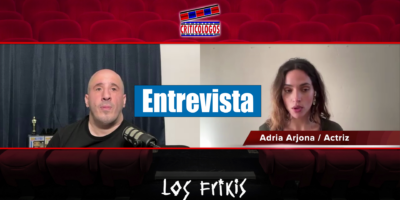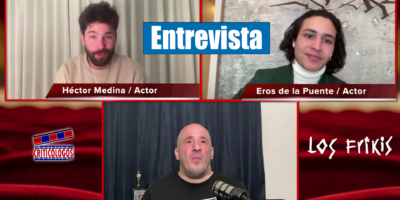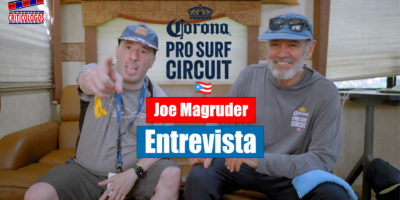
A chat with “Prey” (Hulu) movie director Dan Trachtenberg, producer Jhane Myers, & actress Amber Midthunder as they dive into the world of Predator. Out August 5 On Hulu!
It has been a little while since we saw your last feature, your first feature, 10 Cloverfield Lane. So why Prey for your second feature film?
Dan Trachtenberg:
I started developing this maybe a year after 10 Cloverfield Lane came out. And the last movie came out in theaters. And then, the Fox-Disney merger happened. And all of those things really delayed this from getting going. But the main inspiration behind it was sort of a confluence of a couple things. One was really wanting to make a movie that was primarily action-driven, mainly told visually, but not wanting to that just be fun, just be a good time, to wanna inject that with heart and emotion.
And so, the idea to pair the, like, engine of a sports movie, of an underdog story with an action movie was a part of the genesis of this. And then, it became, like, well what if the story could focus on characters that normally are not the heroes of the movie that they’re in? So that, the watching of the movie could be linked to the experience that the characters go through.
So, that led me down, I think, remembering something from early in my childhood when I was not allowed to watch R-rated movies, and being in the minivan on the way to a karate tournament, and all of the sixth graders had just seen Predator. And I was not allowed to see it. And they described the entire movie to me on the trip to the karate tournament. And the one thing they said that really stuck with me was there was a fight on a bridge over a waterfall between Billy, the Native-American tracker, and the Predator.
And then I saw the movie eventually, years later, and that scene is not in the movie. And I’d always wanted to see that and really thinking about oh, we’ve seen a lot of movies that are focused on Arnold Schwarzenegger and that kind of hero. What if we focused a movie on a different kind of character? So all of that sort of swirled and came together into the genesis of this movie.

You just have so much on your shoulders with this film. So when you first booked the role, was there anything about the project that made you say or think, you know, this particular thing is going to be the most challenging for me? And then, is that how things panned out? Was that thing the most challenging or did something else catch you by surprise on set?
Amber Midthunder:
You know, I don’t feel like I’ve said this to anybody, my immediate reaction, ’cause I auditioned for this movie, originally, in early 2020, like pre-pandemic, Dan and I met. And then it disappeared, like similar experience to Dakota kind of it, like, disappeared from my life for a while, and then it came back. Then it was, like, like, oh, hey, it was under, you know, like a working title. And somebody said, like, oh, this movie is back. And I think they want you to audition again. I was like, what is that? And I was auditioning, I didn’t know what it was. And somebody told me it was Predator and I cried.
And I had not had the job yet. And it wasn’t even like good tears. It was like scary. It was like scared tears. Just at the concept of like, how big everything I think seemed and like, when I read the script for the first time, I remember reading like 30 straight pages of action. Like it was just action description for like, so… I was like, how long is this? And still, somehow I didn’t realize what, like, what that would actually feel like, like in your body when you’re there, all of us together.
‘Cause, you know, we were up in Canada for like six months, still, like the country was closed. It was COVID. So, you know, none of us… Like our families couldn’t come. It was really just like us and each other. I think the COVID element and the system that, that creates with everybody who was like giving so much to make this movie is something that I could never have expected.

Because one of the most remarkable things about this movie is the atmosphere and the level of detail that we see here. So can you tell us a little bit about how historically accurate everything we see in Prey is?
Jhane Myers:
It was as historically accurate as we can get it because if you think about the time when this was, this was, you know, there weren’t a lot of photographs and you know, paintings. You know, just some of the paintings that were out were kind of slighted, like, if somebody could only paint like in one style.
So for me, that was amazing, because it gave us a little bit of leeway. But being a traditional artist as well, you know, as a producer, and all my many hats I was able to really infuse it with all things Comanche, you know, whether it’s the color of the earth paints that we use, whether it’s the designs, whether it’s the twisted fringe, you know, whether it’s fighting style, whether it’s language, you know, all of that just came together.
So for me, it was a dream. I mean, there will never probably be another project unless we do a sequel, Dan, a sequel to the prequel that, that would ever, you know, cross my path where I could use everything that I grew up learning.
Can you give us an example of a smaller but important detail that people should look out for, something that maybe isn’t, you know, explained out loud in the movie or really specifically focused on visually, but it’s there, it has great meaning, and we can feel it influencing the characters?
Dan Trachtenberg:
Hmm, I can think of a slightly less meaningful answer but a fun answer for fans of Predator is the way in which Taabe, Dakota’s character is cut when he gets cut. It’s in a very specific way. Yeah.




